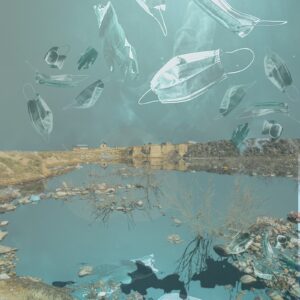
By Clara Lee
Edited by Mease Brockman
#socialpolicy
Climate Change and Forced Migration
The world is experiencing natural disasters such as floods, droughts, wildfires, and extreme weather more frequently and more severely.1 As a result, more than 221 million people have been displaced due to disasters in the last decade.2
Figure 1. New displacement from 2011 to 2021.3
Scientists expect extreme rainfall events to double or triple with each increase in degrees Celsius.4 If the temperature rises by 1.5 degrees Celsius, about 14% of the world’s population will experience extreme heat waves every five years, and 350 million additional people will be exposed to heat stress by 2050.5 If the earth warms by two degrees Celsius, an additional 60 million people in urban areas will be exposed to severe drought.6 This exposure would force people to migrate. The World Bank predicts that—if no action is taken—more than 200 million people will be forced to move.7 This means, because of climate change, one in every 45 people in the world would be displaced by 2050.8
Effects of Climate Change on the People of the Northern Triangle Region
El Salvador, Guatemala, and Honduras (together known as the Northern Triangle Region) are among the most exposed countries to natural disasters in the world.9 These countries have become warmer and drier as a result of climate change and have suffered from prolonged droughts since 2014.10 The impact of the El Niño phenomenon on crop loss has already been reported to be dire; in 2016, 50-90% of crop harvests were lost.11
Climate change has increased economic instability in Northern Triangle countries, as approximately one-third of the population depends on agriculture as their main source of income.12 The rural communities and indigenous people in the Northern Triangle are among the most vulnerable to climate change. The number of people living in poverty in rural areas has increased in the past few decades.13 In Guatemala, the malnutrition rate for children under the age of five has reached 59.6% of the rural population and 65.9% of the indigenous population from 2004 to 2012.14 In the past two years, this region has experienced additional suffering from the COVID-19 pandemic and natural disasters. The Northern Triangle region was hit by Tropical Storms Amanda and Cristobal, and Hurricanes Eta and Iota, destroying homes, buildings, and land.15 Climate change has deteriorated local agriculture and fertilized lands, and frequent natural hazards have damaged the local habitat, crops, livestock, and infrastructure. This has resulted in food insecurity, economic instability, and poverty.16
Figure 2. Impacts of the El Niño phenomenon on Guatemala, Honduras, and El Salvador around 2015.17
According to a 2017 World Food Programme (WFP) survey of Central America, about 47% of interviewees from the area’s Dry Corridor were food insecure—the highest level reported in this region.18 The research by WFP suggests there is a link between food insecurity and migration, and migration is seen as the “ultimate coping strategy,” as seen in Figure 3.19
Figure 3. Coping strategy for food insecurity.20
The Most Vulnerable Are on the Move
One of the major groups of migrants from the Northern Triangle to the United States (U.S.) are rural families who depend on agriculture as their main source of income.21 Migration from northern Central America has increased by 59% between 2000 and 2010.22 From FY14 to FY20, an average of 311,000 people from the Northern Triangle region left for the U.S. each year and about 700,000 people left in FY19.23 Although there was a sharp decrease in 2020 due to the COVID-19 pandemic, surveys conducted in 2020 indicate that individuals who had paused their plans to migrate to the U.S. intend to resume their journey when the cross-border travel restrictions are lifted.24
Figure 4. U.S. apprehensions and expulsions of Guatemalan, Honduran, and Salvadoran at the Southwest Border: FY11-FY21.25
There has been an increase in the number of families and unaccompanied minors migrating from the Northern Triangle region to the U.S. In May 2019, more than 130,000 individuals—the highest in eleven years—were captured along the U.S.-Mexico border. 80% of these individuals were families and unaccompanied minors from El Salvador, Guatemala, and Honduras.26 Since 2014, the main group seeking asylum in the U.S. has changed from single adult males from Mexico to families and unaccompanied minors from the Northern Triangle countries.27 It is projected that the number of families and unaccompanied children from the Northern Triangle seeking refuge in the U.S. will continue to grow as climate change exacerbates food insecurity and poverty in the region.28
Refugee Considerations
Current U.S. immigration law does not recognize people who migrate due to natural disasters and climate change as qualified to be protected as refugees. The Immigration and Nationality Act (INA) defines a refugee as a person “who is unable or unwilling to return to and is unable or unwilling to avail himself or herself of the protection of, that country because of persecution or a well-founded fear of persecution on account of race, religion, nationality, membership in a particular social group, or political opinion.”29 This definition, however, is prohibitively narrow and fails to include individuals in need of humanitarian assistance due to climate change. The effects of climate change are less about persecution, but rather more about food insecurity, economic instability, and poverty. It may be possible for climate migrants to be considered a “particular social group” to be recognized as refugees. However, policy experts regard the chances of the U.S. immigration officials regarding climate migrants as a “particular social group” as slim.30
Temporary Protected Status (TPS)
The U.S. has some policies in place that can assist climate migrants. According to the Immigration Act of 1990, Temporary Protected Status (TPS) is provided if migrants are “subject to armed conflict, natural disaster, or other extraordinary temporary conditions.”31 TPS beneficiaries are protected from removal, receive work authorization, and may get travel authorization.32 However, TPS fails to recognize climate migrants in many ways. TPS only applies to nationals who are already in the U.S. and are unable to return home due to conflict, disasters, and other extraordinary and temporary circumstances. This policy, then, does not apply to individuals who have migrated because of natural disasters. Furthermore, TPS is only applicable to nationals of designated countries.33 As of February 2023, among the Northern Triangle countries, El Salvador and Honduras are designated countries for TPS, but Guatemala is not.34
In addition, the designation process is restricted. The presence of natural disasters alone do not ensure the designation. Countries need to meet specific requirements to qualify. The U.S. Secretary of Homeland Security must determine if the conditions in a foreign country prevent individuals from returning or if the country is incapable of managing the return of its nationals.35 Scholars criticize the U.S. for its lack of transparency on how certain countries receive TPS designation and others do not.36 Moreover, to receive TPS designation, countries that are affected by natural disasters also need to request that the U.S. not send their nationals back, which adds a limitation to the designation as governments tend to not admit their failures.37 Furthermore, even though individuals receive TPS, the status is only applicable for a certain period, which suggests that TPS is not a long-lasting solution.
The Deferred Enforced Departure (DED)
Deferred Enforced Departure (DED) is another possible blanket relief that protects individuals who are affected by climate change. Unlike TPS, the president has the discretion to authorize the DED status.38 While it is not an immigration status, individuals are protected from removal, normally for a certain period.39 Like TPS, DED is also limited to individuals from designated countries and only provides temporary status. DED has been applied to seven countries since 1990, and currently only three countries—Liberia, Venezuela, and Hong Kong— are listed as designated countries.40 Individuals from El Salvador, Guatemala, and Honduras are not eligible for DED as these are not designated countries.
Humanitarian Parole
Humanitarian parole is another pathway available, yet it also fails to cover climate migrants. The Central American Minors program was specifically created to assist minors from El Salvador, Guatemala, and Honduras. The program was in place from 2014 to 2017 and was recently resumed by President Biden in 2021.41 It offers “an opportunity to apply for refugee status and possible resettlement in the United States” to “certain qualified children” and family members of the children.42 However, due to the restrictive eligibility requirements for the program, not many individuals can enjoy the benefits.43 From 2014 to 2017, 10,500 people applied, and only 3,092 people were accepted.44 The benefits of the program are also very limited; permanent immigration status is not provided and medical or other welfare benefits are not guaranteed.45
Next Steps: Policy Recommendations
It is important to expand the definition of refugees to encompass individuals who are migrating due to climate change. United Nations High Commissioner for Refugees (UNHCR) has released new considerations to protect displaced persons due to the effects of climate change and natural disasters.46 Incorporating this guidance into U.S. refugee policy would allow climate-displaced persons to be recognized as refugees. The term “refugee” carries great power since refugee status allows individuals to be protected under the immigration system and provides formal status and resettlement opportunities.47
Expanding existing policies, such as Temporary Protected Status (TPS), Deferred Enforced Departure (DED), and Humanitarian Parole, will benefit climate migrants from the Northern Triangle region.48 These policies have their limitations, but expanding already existing policies is more expedient and feasible than creating new ones. Admissions and protections for these pathways need to be expanded to better assist climate migrants from the Northern Triangle countries.49
Creating protection and resettlement pathways specifically for climate migrants is also a policy imperative. Current pathways are only applicable for a limited time period, which is not a long-term solution that can protect climate-displaced individuals. The effects of climate change are not temporary, and more long-term policy is needed.
Conclusion
Climate change is happening now and is already forcing migration. The recognition of climate migrants has grown, and President Biden has placed an executive order to “prepare and submit to the President a report on climate change and its impact on migration, including forced migration, internal displacement, and planned relocation.”50 With this recognition in hand, it is time to analyze current policies on immigration and implement suitable policies to protect vulnerable cohorts who are forced to migrate due to climate change. The suffering of climate effects has been ongoing in the Northern Triangle region for decades bringing prolonged droughts and more frequent storms. Rural communities and indigenous groups are among the most vulnerable, as they are hit directly by the effects of climate change. The number of migrants due to climate change is expected to continue growing, and appropriate policies are needed to provide support.
Endnotes
1. Seneviratne, S.I., X. Zhang, M. Adnan, W. Badi, C. Dereczynski, A. Di Luca, S. Ghosh, I. Iskandar, J. Kossin, S. Lewis, F. Otto, I. Pinto, M. Satoh, S.M. Vicente-Serrano, M. Wehner, and B. Zhou. 2021: Weather and Climate Extreme Events in a Changing Climate. In Climate Change 2021: The Physical Science Basis. Contribution of Working Group I to the Sixth Assessment Report of the Intergovernmental Panel on Climate Change [Masson-Delmotte, V., P. Zhai, A. Pirani, S.L. Connors, C. Péan, S. Berger, N. Caud, Y. Chen, L. Goldfarb, M.I. Gomis, M. Huang, K. Leitzell, E. Lonnoy, J.B.R. Matthews, T.K. Maycock, T. Waterfield, O. Yelekçi, R. Yu, and B. Zhou (eds.)]. Cambridge University Press, Cambridge, United Kingdom and New York, NY, USA, pp. 1513–1766, doi: 10.1017/9781009157896.013.
2. “Global Internal Displacement Database.” n.d. IDMC. Accessed September 15, 2021. https://www.internal-displacement.org/database/displacement-data.
3. ibid
4. Myhre, G., K. Alterskjær, C. W. Stjern, Ø. Hodnebrog, L. Marelle, B. H. Samset, J. Sillmann, et al. 2019. “Frequency of Extreme Precipitation Increases Extensively with Event Rareness under Global Warming.” Scientific Reports 9 (1): 16063. https://doi.org/10.1038/s41598-019-52277-4.
5. Buis, Alan. 2019. “A Degree of Concern: Why Global Temperatures Matter.” NASA Global Climate Change: Vital Signs of the Planet. June 19, 2019. https://climate.nasa.gov/news/2865/a-degree-of-concern-why-global-temperatures-matter.
6. ibid
7. Clement, Viviane, Kanta Kumari Rigaud, Alex de Sherbinin, Bryan Jones, Susana Adamo, Jacob Schewe, Nian Sadiq, and Elham Shabahat. 2021. “Report: Climate Change Could See 200 Million Move by 2050.” AP NEWS. September 13, 2021. https://apnews.com/article/africa-climate-environment-and-nature-immigration-europe-69cada32a7c13f80914a2a7b48fb5b9c.
8. Brown, Oli. 2008. “Migration and Climate Change.” United Nations. https://www.un-ilibrary.org/content/books/9789213630235,.
9. Sigelmann, Laura. 2019. “The Hidden Driver: Climate Change and Migration in Central America’s Northern Triangle.” The American Security Project. https://www.americansecurityproject.org/perspective-climate-change-and-migration-in-central-americas-northern-triangle/.
10. Meyer, Peter J. 2021. “Central American Migration: Root Causes and U.S. Policy.” CRS Report No. IF11151. https://crsreports.congress.gov/product/details?prodcode=IF11151.
11. Food and Agriculture Organization of the United Nations. 2016. “Dry Corridor – Situation Report June 2016 : FAO in Emergencies.” June 2016. http://www.fao.org/emergencies/resources/documents/resources-detail/en/c/422097/.
12. Sigelmann, Laura. 2019. “The Hidden Driver: Climate Change and Migration in Central America’s Northern Triangle.” The American Security Project. https://www.americansecurityproject.org/perspective-climate-change-and-migration-in-central-americas-northern-triangle/.
13. Economic Commission for Latin America and the Caribbean. 2018. Atlas of Migration in Northern Central America. (LC/PUB.2018/23). Santiago: CEPAL. https://www.cepal.org/en/publications/44288-atlas-migration-northern-central-america.
14. ibid
15. Food and Agriculture Organization of the United Nations. 2021. “Anticipatory Actions to Safeguard the Food Security and Livelihoods of Vulnerable Farmers and Herders in the Dry Corridor of El Salvador, Honduras and Guatemala.” July 28, 2021. http://www.fao.org/emergencies/fao-in-action/stories/stories-detail/en/c/1418028/.
16. Tower, Amali. 2021. “Climate Refugees Policy Recommendations to US Government Agencies on Climate Displacement.” Climate Refugees. June 14, 2021. https://www.climate-refugees.org/reports/usagency-policybrief-climatedisplacement.
17. Economic Commission for Latin America and the Caribbean. 2018. Atlas of Migration in Northern Central America. (LC/PUB.2018/23). Santiago: CEPAL. https://www.cepal.org/en/publications/44288-atlas-migration-northern-central-america.
18. World Food Programme. 2017. “Food Security and Emigration: Why People Flee and the Impact on Family Members Left behind in El Salvador, Guatemala and Honduras.” September 2017. https://www.wfp.org/publications/2017-food-security-emigration-why-people-flee-salvador-guatemala-honduras.
19. ibid
20. ibid
21. Economic Commission for Latin America and the Caribbean. 2018. Atlas of Migration in Northern Central America. (LC/PUB.2018/23). Santiago: CEPAL. https://www.cepal.org/en/publications/44288-atlas-migration-northern-central-america.
22. ibid
23. Meyer, Peter J. 2021. “Central American Migration: Root Causes and U.S. Policy.” CRS Report No. IF11151. https://crsreports.congress.gov/product/details?prodcode=IF11151.
24. ibid
25. ibid
26. Sigelmann, Laura. 2019. “The Hidden Driver: Climate Change and Migration in Central America’s Northern Triangle.” The American Security Project. https://www.americansecurityproject.org/perspective-climate-change-and-migration-in-central-americas-northern-triangle/.
27. ibid
28. ibid
29. “8 U.S. Code § 1101.” 1995. January 4, 1995. https://uscode.house.gov/view.xhtml?req=child+pornography&f=treesort&fq=.
30. Yayboke, Erol, Trevor Houser, Janina Staguhn, and Tani Salma. 2020. “A New Framework for U.S. Leadership on Climate Migration.” Center for Strategic and International Studies.
31. “Immigration Act of 1990, S.358 – 101st Congress (1989-1990).” 1990. Legislation. 1989/1990. November 29, 1990. https://www.congress.gov/bill/101st-congress/senate-bill/358.
32. U.S. Citizenship and Immigration Services. 2023b. “Temporary Protected Status | USCIS.” February 15, 2023. https://www.uscis.gov/humanitarian/temporary-protected-status.
33. ibid
34. ibid
35. ibid
36. Kerwin, Donald. 2014. “Creating a More Responsive and Seamless Refugee Protection System: The Scope, Promise and Limitations of US Temporary Protection Programs.” Journal on Migration and Human Security 2 (1): 44–72. https://doi.org/10.1177/233150241400200104.
37. Frelick, Bill. 2020. “What’s Wrong with Temporary Protected Status and How to Fix It: Exploring a Complementary Protection Regime.” Journal on Migration and Human Security 8 (1): 42–53. https://doi.org/10.1177/2331502419901266.
38. U.S. Citizenship and Immigration Services. 2023a. “Deferred Enforced Departure | USCIS.” January 26, 2023. https://www.uscis.gov/humanitarian/deferred-enforced-departure.
39. U.S. Citizenship and Immigration Services. 2021a. “Deferred Enforced Departure.” August 17, 2021. https://www.uscis.gov/humanitarian/deferred-enforced-departure.
40. Wilson, Jill. 2021. “Temporary Protected Status and Deferred Enforced Departure.” CRS Report No. RS20844. https://crsreports.congress.gov/product/details?prodcode=RS20844
41. The National Immigration Forum. 2021. “Fact Sheet: Central American Minors (CAM) Program.” The National Immigration Forum. March 19, 2021. https://immigrationforum.org/article/fact-sheet-central-american-minors-cam-program/.
42. U.S. Citizenship and Immigration Services. 2021b. “Central American Minors (CAM) Refugee and Parole Program.” September 14, 2021. https://www.uscis.gov/CAM.
43. The National Immigration Forum. 2021. “Fact Sheet: Central American Minors (CAM) Program.” The National Immigration Forum. March 19, 2021. https://immigrationforum.org/article/fact-sheet-central-american-minors-cam-program/.
44. ibid
45. Negroponte, Diana Villiers. 2014. “A Refugee and Parole Program for Central American Minors.” Brookings (blog). November 20, 2014. https://www.brookings.edu/blog/up-front/2014/11/20/a-refugee-and-parole-program-for-central-american-minors/.
46. United Nations High Commissioner for Refugees. 2020. “Legal Considerations Regarding Claims for International Protection Made in the Context of the Adverse Effects of Climate Change and Disasters.” Refworld. October 1, 2020. https://www.refworld.org/docid/5f75f2734.html.
47. Yayboke, Erol, Trevor Houser, Janina Staguhn, and Tani Salma. 2020. “A New Framework for U.S. Leadership on Climate Migration.” Center for Strategic and International Studies.
48. Tower, Amali. 2021. “Climate Refugees Policy Recommendations to US Government Agencies on Climate Displacement.” Climate Refugees. June 14, 2021. https://www.climate-refugees.org/reports/usagency-policybrief-climatedisplacement.
49. ibid
50. White House Press Office. 2021. “Executive Order on Rebuilding and Enhancing Programs to Resettle Refugees and Planning for the Impact of Climate Change on Migration.” February 5, 2021. https://www.whitehouse.gov/briefing-room/presidential-actions/2021/02/04/executive-order-on-rebuilding-and-enhancing-programs-to-resettle-refugees-and-planning-for-the-impact-of-climate-change-on-migration/.





